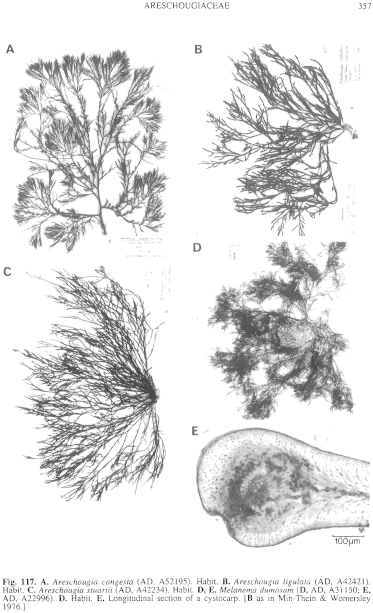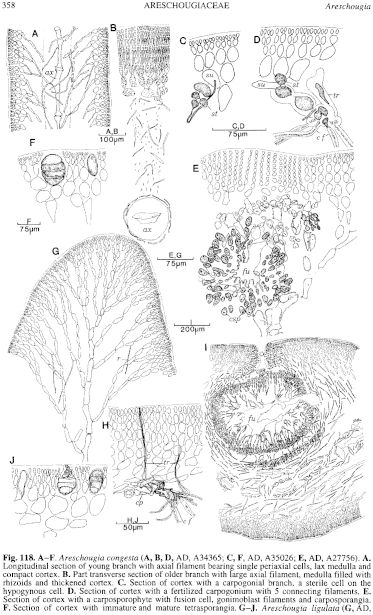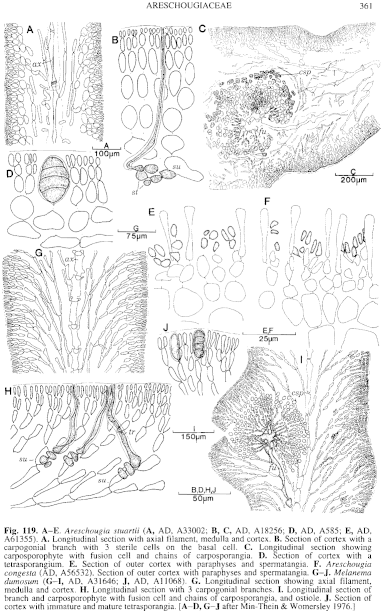|
|
|
|
|
|||||||||||
|
Electronic Flora of South Australia Species Fact Sheet
Phylum Rhodophyta – Class Florideophyceae – Order Gigartinales – Family Areschougiaceae
Selected citations: Min-Thein & Womersley 1976: 55, figs 18, 19, 57.
Synonyms
Fucus congestus Turner 1811: 105, pl. 179.
Thamnocarpus (?) laurencia Hooker & Harvey 1847: 409.
Areschougia laurencia (Hooker & Harvey) Harvey 1855a: 554; 1860a: 321; 1863, synop.: xli. J. Agardh 1872: 26; 1876: 282. Kylin 1932: 37. Lucas & Perrin 1947: 174.
Carpothamnion laurencia (Hooker & Harvey) Kützing 1849: 669; 1868: 5, pl. 14a-c.
Areschougia gracilarioides Harvey 1863: synop.: xli.
Phacelocarpus densus Areschoug 1854: 347.
Solieria compressa J. Agardh 1892: 115. Kylin 1932: 20, pl. 6 fig. 11.
Thallus (Fig. 117A) dark brown-red, 10–40 cm high, much branched irregularly with terete (to slightly compressed) linear to tapering branches, basally constricted with rounded to pointed apices, above 300–800 µm in diameter, mid branches 0.4–1 mm in diameter, becoming 1–2 (–4) mm broad (slightly compressed) in lower axes. Holdfast discoid, 2–10 mm across, with a single axis (rarely several); epilithic. Structure (Fig. 118A) uniaxial, with each axial cell producing a single periaxial cell, on three radii on successive cells, forming a lax medulla of periaxial filaments (soon becoming filled with rhizoids, densely below) and a pseudoparenchymatous cortex 4–8 cells thick, inner cells ovoid and 20–40 µm in diameter, outer cells 4–6 µm in diameter, L/D 1–1.5; axial filament conspicuous throughout the thallus, and the older parts (Fig. 118B) thickened by a cortical meristem. Rhodoplasts discoid, becoming ribbon shaped, several per cell.
Reproduction: Sexual thalli dioecious; non-procarpic. Carpogonial branches (Fig. 118C) 3 (–4)-celled, borne on inner cortical cells, directed inwards or sideways with reflexed trichogynes, the hypogynous or basal cell usually with 1–2 sterile cells. Connecting filaments (Fig. 118D) 3–5, non-septate, occasionally branched, uniting with the auxiliary cell which is an outer medullary or inner cortical cell, with adjacent cells becoming darkly staining after diploidization and cutting off nutritive filaments. Gonimoblast initial first inwards, later radial from the fusion cell (Fig. 118E) with a prominent stalk, producing short chains of ovoid carposporangia (20–) 30–60 µm in diameter. Cystocarps swelling the upper branches, with lax filamentous enveloping tissue and the adjacent cortex increasing in thickness and becoming ostiolate. Spermatangia (Fig. 119F) in nemathecia on young branches, in clusters between clavate paraphyses 24–35 µm long, ends 4–6 µm in diameter, with outer cortical cells cutting off 2–3 mother cells each producing 2–4 ovoid to pointed spermatangia 2–4 µm in diameter.
Tetrasporangia (Fig. 118F) scattered within the cortex, developed from inner cortical cells and laterally pit-connected to adjacent cells, ovoid, 80–110 µm long and 50–70 µm in diameter, zonately divided.
Type from Kent Is, Bass Strait (Brown); holotype in BM.
Selected specimens: Hamelin Bay, W. Aust., drift (Royce 708, 21.vi.1950; AD, A15492). Eucla, W. Aust., drift (Womersley, 2.ii.1954; AD, A19370). Elliston, S. Aust., 10–11 m deep in bay (Shepherd, 20.x.1969; AD, A35026). Douglas Bank, upper Spencer Gulf, S. Aust., 20 m deep (Johnson, 19.xi.1975; AD, A54886). Gleeson Landing, Yorke Pen., S. Aust., drift (St Clair, 5.iii.1986; AD, A57491). Marion Bay, S. Aust., drift (Gordon-Mills, 23.v,1981; AD, A52195). Port Noarlunga, S. Aust., 2–3 m deep (Owen & Hergstrom, 19.vii.1970; AD, A35963). Pennington Bay, Kangaroo I., S. Aust., drift (Womersley, 27.i.1946; AD, A2924). D'Estrees Bay, Kangaroo I., S. Aust., drift (Seppelt, 28.viii.1972; AD, A42636). Robe, S. Aust., drift (Womersley, 9.ix.1968; AD, A32687). Lawrence Rock, Portland, Vic., 8–11 m deep (Larkum, 2.ix.1971; AD, A39653). Lighthouse Point, Queenscliff, Vic., 12–14 m deep (Goldsworthy, 9.ii.1990; AD, A60155). Crawfish Rock, Westernport Bay, Vic., 10 m deep (Watson, 25.iv.1969; AD, A34365) and 1 m deep (Watson, 25.xi.1971; AD, A42191 -"Marine Algae of southern Australia" No. 158). Walkerville, Vic., drift (Sinkora A1626, 23.ii.1972; AD, A43133). Bombay Rock, Tamar Est., Tas., upper sublittoral (Womersley, 27.i.1949; AD, A10404). Orford, Tas., drift (Wollaston & Mitchell, 1.iii.1964; AD, A27756). Lady Bay, Southport, Tas., 3–5 m deep (Brown & Womersley, 28.x.1982; AD, A56532).
Distribution: Hamelin Bay, W. Aust., to Walkerville, Vic., and around Tasmania. Lord Howe I.(?) (see Millar & Kraft 1993, p. 25).
Taxonomic notes: Areschougia congesta is a common alga in southern Australia, especially on rough-water coasts where it is relatively robust, but extending into calmer situations where it is generally slenderer.
Rhabdonia compressa J. Agardh (1892, p. 115) from Tasmania, holotype in Herb. Agardh, LD, 34587, is probably A. congesta and not a Solieria.
References:
AGARDH, J.G. (1872). Bidrag till Florideernes Systematik. Acta Univ. hind. 8, 1–60.
AGARDH, J.G. (1876). Species Genera et Ordines Algarum. Vol. 3, Part 1 - Epicrisis systematis Floridearum, pp. i-vii, 1–724. (Weigel: Leipzig.)
AGARDH, J.G. (1892). Analecta Algologica. Acta Univ. lund. 28, 1–182, Plates 1–3.
ARESCHOUG, J.E. (1854). Phyceae novae et minus cognitae in maribus extraeuropaeis collectae. Ups. Soc. Sci. nova Acta, Ser. III, 1, 329–72.
HARVEY, W.H. (1855a). Some account of the marine botany of the colony of Western Australia. Trans. R. Ir. Acad. 22, 525–566.
HARVEY, W.H. (1860a). Algae. In Hooker, J.D., The Botany of the Antarctic Voyage. 111. Flora Tasmaniae. Vol. II, pp. 321–343, Plates 185–196.
HARVEY, W.H. (1863). Phycologia Australica. Vol. 5, Plates 241–300, synop., pp. i-lxxiii. (Reeve: London.)
HOOKER, J.D. & HARVEY, W.H. (1847). Algae Tasmanicae. Lond. J. Bot. 6, 397–417.
KÜTZING, F.T. (1849). Species Algarum. (Leipzig.)
KÜTZING, F.T. (1868). Tabulae Phycologicae. Vol. 18. (Nordhausen.)
KYLIN, H. (1932). Die Florideenordnung Gigartinales. Lunds Univ. Årsskr. N.F. Avd. 2, 28 (8), 1–88, Plates 1–28.
LUCAS, A.H.S. & PERRIN, F. (1947). The Seaweeds of South Australia. Part 2. The Red Seaweeds. (Govt Printer: Adelaide.)
MILLAR, A.J.K. & KRAFT, G.T. (1993). Catalogue of Marine and Freshwater Red Algae (Rhodophyta) of New South Wales, including Lord Howe Island, South-western Pacific. Aust. Syst. Bot. 6, 1–90.
MIN-THEIN, U. & WOMERSLEY, H.B.S. (1976). Studies on southern Australian taxa of Solieriaceae, Rhabdoniaceae and Rhodophyllidaceae (Rhodophyta). Aust. J. Bot. 24, 1–166.
TURNER, D. (1811). Fuci sive Plantarum Fucorum Generi a Botanicis Ascriptarum Icones Descriptiones et Historia. Vol. 3, pp. 1–148, Plates 135–196. (London.)
The Marine Benthic Flora of Southern Australia Part IIIA complete list of references.
Publication:
Womersley, H.B.S. (14 January, 1994)
The Marine Benthic Flora of Southern Australia
Rhodophyta. Part IIIA, Bangiophyceae and Florideophyceae (to Gigartinales)
Reproduced with permission from The Marine Benthic Flora of Southern Australia Part IIIA 1994, by H.B.S. Womersley. Australian Biological Resources Study, Canberra. Copyright Commonwealth of Australia.
Illustrations in Womersley Part IIIA, 1994: FIGS 117A, 118 A–F, 119F.

Figure 117 enlarge
Fig. 117. A. Areschougia congesta (AD, A52195). Habit. B. Areschougia ligulata (AD, A42421). Habit. C. Areschougia stuartii (AD, A42234). Habit. D, E. Melanema dumosum (D, AD, A31150; E, AD, A22996). D. Habit. E. Longitudinal section of a cystocarp. [B as in Min-Theis & Womersley 1976.]

Figure 118 enlarge
Fig. 118. A–F. Areschougia congesta (A, B, D, AD, A34365; C, F, AD, A35026; E, AD, A27756). A. Longitudinal section of young branch with axial filament bearing single periaxial cells, lax medulla and compact cortex. B. Part transverse section of older branch with large axial filament, medulla filled with rhizoids and thickened cortex. C. Section of cortex with a carpogonial branch, a sterile cell on the hypogynous cell. D. Section of cortex with a fertilized carpogonium with 5 connecting filaments. E. Section of cortex with a carposporophyte with fusion cell, gonimoblast filaments and carposporangia. F. Section of cortex with immature and mature tetrasporangia. G–J. Areschougia ligulata (G, AD, A28597; H, AD, A6921; I, AD, A10734; J, AD, A10732). G. Longitudinal section of branch apex. H. Section of cortex with a carpogonial branch (on left) and a fertilized carpogonium with several connecting filaments. I. Section of branch and a carposporophyte, with fusion cell and chains of carposporangia, ostiole, and slight enveloping tissue (with germinating carposporangia). J. Section of cortex with immature and mature tetrasporangia (the upper spore developing). [A–J after Min-Thein & Womersley 1976.]

Figure 119 enlarge
Fig. 119. A–E. Areschougia stuartii (A, AD, A33002; B, C, AD, A18256; D, AD, A585; E, AD, A61355). A. Longitudinal section with axial filament, medulla and cortex. B. Section of cortex with a carpogonial branch with 3 sterile cells on the basal cell. C. Longitudinal section showing carposporophyte with fusion cell and chains of carposporangia. D. Section of cortex with a tetrasporangium. E. Section of outer cortex with paraphyses and spermatangia. F. Areschougia congesta (AD, A56532). Section of outer cortex with paraphyses and spermatangia. G–J. Melanema dumosum (G–I, AD, A31646; J, AD, A11068). G. Longitudinal section showing axial filament, medulla and cortex. H. Longitudinal section with 3 carpogonial branches. I. Longitudinal section of branch and carposporophyte with fusion cell and chains of carposporangia, and ostiole. J. Section of cortex with immature and mature tetrasporangia. [A–D, G–J after Min-Thein & Womersley 1976.]

|
Email Contact: State Herbarium of South Australia |

|